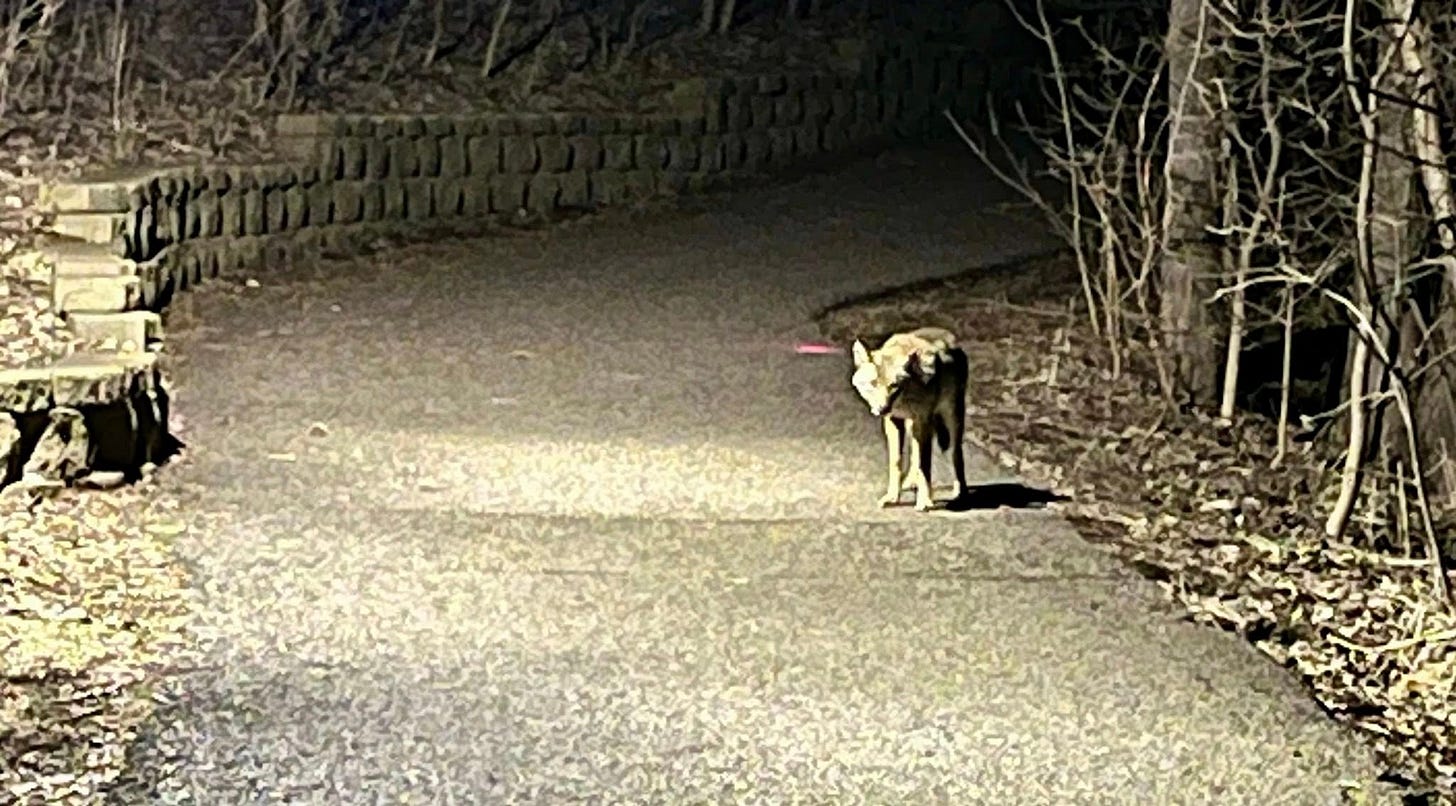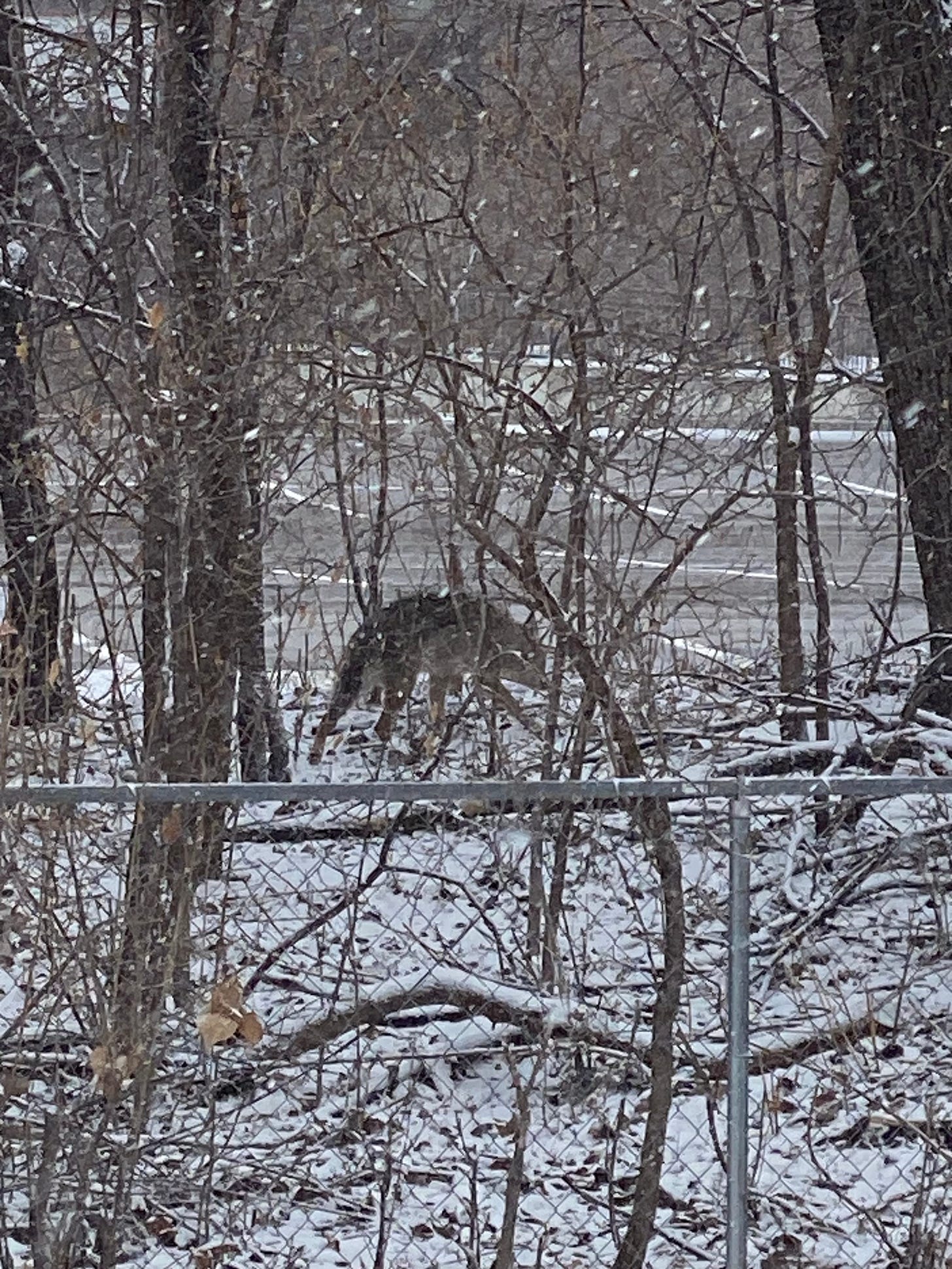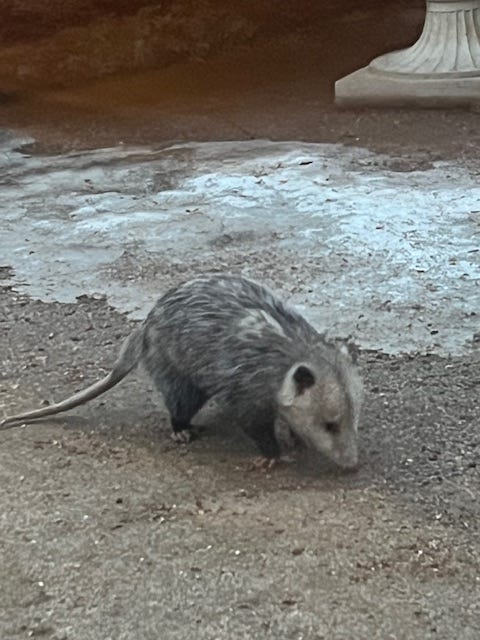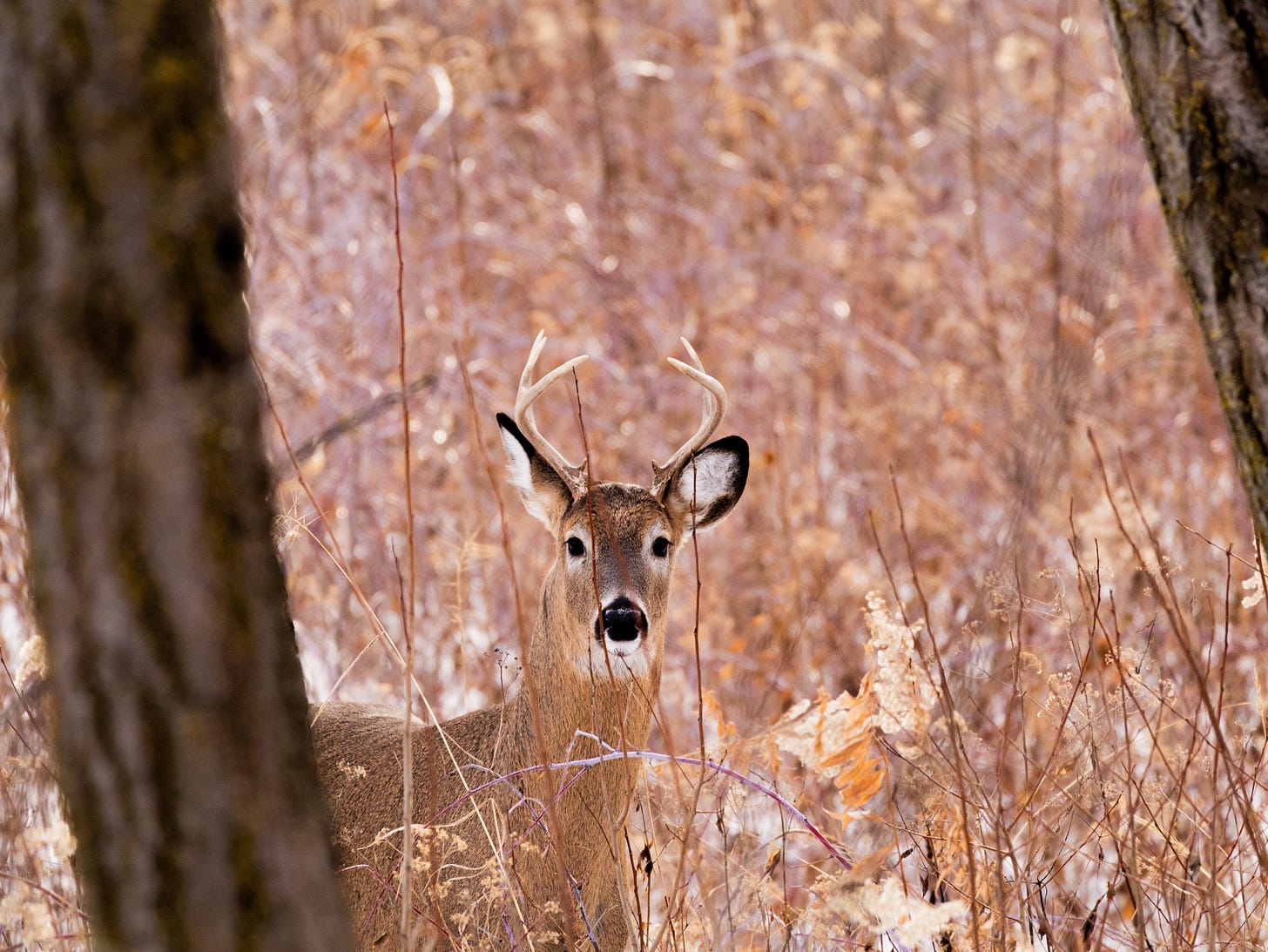Spring wildlife sightings in Roseville
Coyotes, sandhill cranes, opossums, and more animals spotted around the community
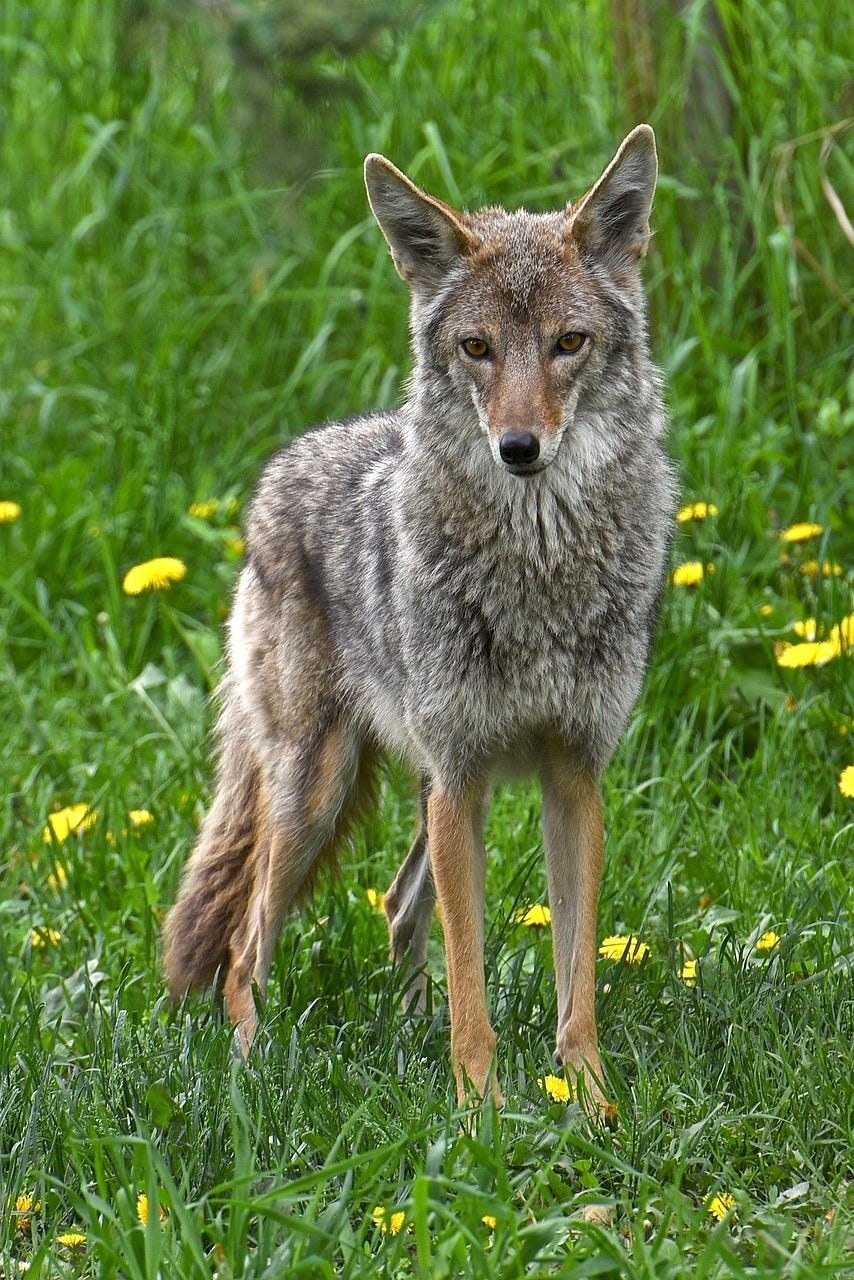
As spring creeps in, Roseville residents are spotting all sorts of animals—such as coyotes and opossums, egrets, turkeys, and sandhill cranes all around the city.
Roseville resident Kurt Franke went for a walk around Bennett Lake in Central Park last week after dark when he and his golden retriever Sunny encountered a coyote.
“At one point Sunny kept looking back behind us. This coyote came out on the path and followed us for a bit. Had to shoo it away a couple times,” Franke wrote in a post in the Roseville MN Neighbors and Community group on Facebook. (Shared here with permission). Franke took this video of the coyote on the trail:
Several others commented with stories of coyote sightings in the community too, including in their own yards, on walks through residential neighborhoods, and in Reservoir Woods.
Roseville resident Luke Buer snapped this photo of a coyote in his backyard on March 30, in the neighborhood just north of County Rd B and West of Snelling Ave.
This wasn’t the first time Buer’s family encountered a coyote in their backyard. In 2023, he heard his four-year-old son yell, “‘Dad, Taco (our dog) made a wolf friend.’ To my surprise, I see the coyote looking at our dog. I opened the sliding glass door and it scampered away,” Buer told the Roseville Reader.
He saw it again in that area on April 13 and a friend told him about one denning near the Ramsey County Library in Roseville too.
Coyotes are native to Minnesota and well adapted to suburban life. Sightings are common this time of year in Roseville. While coyotes don’t hibernate and can be seen year-round, mating season is January-February and pups are usually born in April, according to the Minnesota DNR. A female coyote could have 5-7 pups and when they are 8-12 weeks old, they teach them how to hunt.
“Most coyotes avoid people and domestic animals. Healthy wild coyotes avoid people, and no attacks have ever occurred in Minnesota,” according to Roseville Parks and Recreation.
The Wildlife Rehabilitation Center of Minnesota (WRC)—located in Roseville—treats coyotes that are injured, sick, or orphaned.
“Last year we treated several that were orphaned and starving as pups. Adult coyotes that come to WRC are often found suffering from severe cases of mange or are hit by cars,” Brittney Yohannes, Communications and Development Director said.
If you encounter a coyote, you should give it space, Yohannes said. And don’t feed them! Feeding coyotes causes them to be habituated to people, which puts both the coyote and people at risk of harm. If you see a coyote that is obviously injured or appears sick, call WRC.
Learn more about urban coyotes from the Minnesota DNR.
Other animals spotted lately in Roseville include large birds such as swans, egrets, turkeys, and sandhill cranes.
Roseville resident Toni Thorson spotted this pair of sandhill cranes crossing the street to Roseville Covenant Church last week and she captured this video, below. (full disclosure: Toni Thorson is this reporter’s mother.)
Sandhill cranes are one of the largest bird species in Minnesota, standing about five feet tall, with a wingspan of seven feet. They are a protected species in Minnesota, except during sandhill crane hunting season in part of northern Minnesota .
Thorson also reported spotting white-tailed deer in her neighborhood near University of Northwestern, mallard ducks in her backyard, and egrets and swans in the pond at Oasis Park. A few weeks ago, she caught sight of an opossum scurrying under her car in the driveway.
“We have opossum around regularly eating spilled birdseed,” said Raye Kanzenbach, a Roseville resident and new member of the Roseville Finance Commission. He’s also seen deer, fox, and downy woodpeckers on his property.
“We have a 3-acre property on Lake Josephine. Lots of action in our yard,” Kanzenbach said.
Virginia Opossums are the only marsupial native to North America. Originally found only in southeastern United States, opossums have expanded their range west and north all the way to northern Minnesota due to warming winters. Opossums mate between January and May and bear two litters of 6 to 20 joeys each year.
White-tailed deer are frequently spotted in Roseville year-round—that’s because the city has .77 square miles of wooded habitat. According to the Minnesota DNR, this is enough habitat for 15-19 deer. The latest reliable estimate counted at least 41 deer in the city in 2021. A survey was not possible in spring of 2024 because of the lack of snow. The city partners with trained sharpshooters from the United States Department of Agriculture (USDA) to reduce the number of deer in certain areas of the city, with a focus on the Reservoir Woods neighborhood in the south and Owasso Hills neighborhood in the north. The USDA donates the meat to people in need. Nineteen deer were removed last winter. This winter’s deer removal totals were not immediately available.
Learn more about the 2024-2025 deer management program in this Sept 4, 2024 update to the Parks and Recreation Commission and the Deer Management page on the Parks and Rec website.
Roseville resident Owen Angellar took this photo, below, in Reservoir Woods in February.
“Many of the deer in the Reservoir Woods are super used to people walking by, so you can get quite close! This instance I saw two young bucks, curious about me and my camera. They didn’t seem to mind my company, so I was able to observe them for close to an hour,” Angellar told the Roseville Reader.
Encountering an injured or sick animal
If you discover an injured or sick animal, call the Wildlife Rehabilitation Center on Dale Street. Volunteers can help you assess whether to bring the animal in or leave it alone. Injured baby animals can be brought directly to WRC without a phone call, but Yohannes encourages people to call first if you suspect a baby animal may be abandoned. Human intervention may not be recommended, so it’s best to check with them. You can leave a voicemail and a volunteer will get back to you within an hour during open hours.
“April is always a turning point for WRC as we transition into baby animal season. Our three baby animal nurseries open to accommodate orphaned and injured baby squirrels and rabbits, ducklings, and songbirds, and many species in between. Many of these babies fall from nests, get injured by dogs and cats, or are separated from their families for one reason or another,” Yohannes said.
Visit the FAQ page for the most common questions about whether or not a baby animal needs help. WRC works hard to ensure they are only admitting animals that actually need help and keeping healthy babies in the wild with their families where they belong.
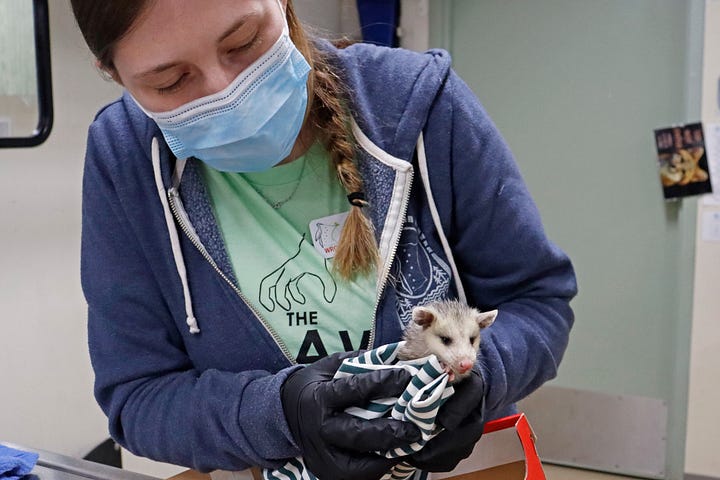

WRC is powered by 500 volunteers and 75 interns and funded by community members who support their mission. WRC is one of the oldest and busiest wildlife hospitals in the entire world, Yohannes explained.
“Thank you to all of our neighbors who volunteer, donate, and bring in wild animals in need!” Yohannes said.
What other wildlife have you spotted in your neighborhood lately? Share about it in the comments.





